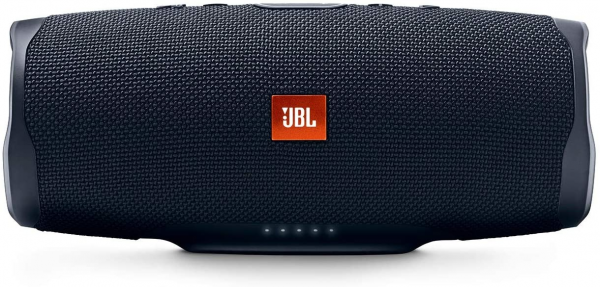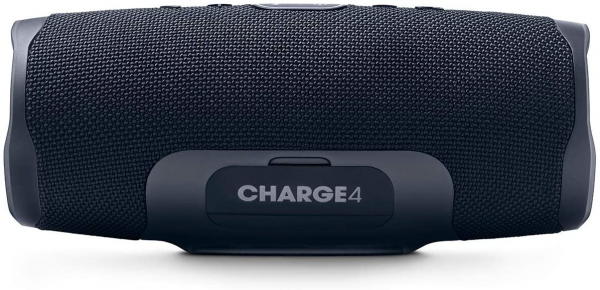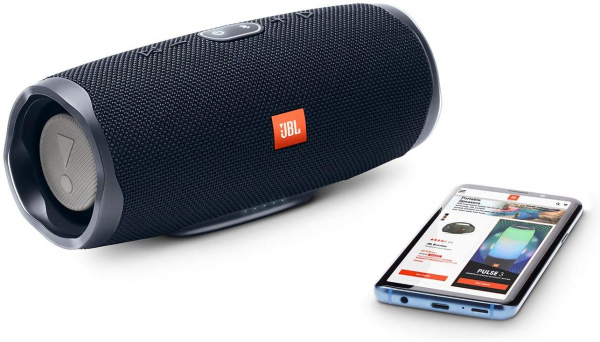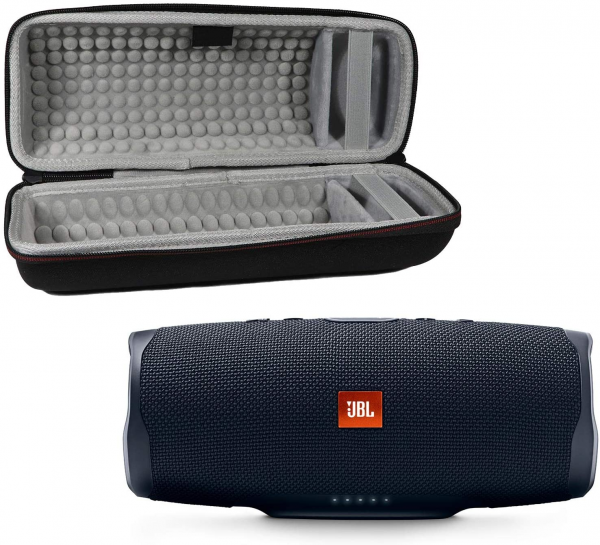JBL
JBL Charge 4 portable speaker: ergonomic evolution against sound regression
Aprox. 139€ - see price -
See specificationsFor this 4th edition of its popular nomad speaker capable of recharging a mobile device, JBL is operating only very slight alterations: greater battery capacity here, promotion to Bluetooth 4.2 there - while guaranteeing the same robustness, autonomy and power.
Positive points
Well built, robust, waterproof.
Excellent autonomy.
Multipoint connection.
Powerful.
Overall balance, voices present.
Bad points
No hands-free kit.
Mono.
Bass under control.
Latency.
Imprecision of high mids / highs.
Our review
Ergonomics
We remember with fun the very first Charge and its rugby ball look. Since then, there has been 2 then 2+, 3, and finally 4, today under the eye of our microscope - or rather under the ear of our measuring microphone.
If the speaker has taken a few generations to find its final shape, the Charge 3 seems to have set the final tone. Apart from its slightly larger volume and weight (960 g), the latest addition is therefore almost identical to its predecessor. We thus find the domed cylindrical appearance, the particularly resistant braided fabric, the rubber for the contact or interaction areas, and more generally the robust construction stamped IPX7, allowing the enclosure to be submerged up to 1 m during 30 minutes.
Despite an above-average volume, the Charge 4 is easy to handle. The fabric covering allows you to grasp it with one hand, the buttons are large and the large non-slip base provides good stability to the speaker, on all types of surfaces - dry, it should be noted. The construction is still resistant to impact and falls.
The buttons provide access to power on / off, activation of Bluetooth pairing, play / pause, skip to the next track and volume control. The JBL Connect function allows, via the dedicated application, to associate the Charge with a sister - in stereo or double mono. It is however impossible to return to the start of the current track or take calls, the speaker being devoid of microphone, therefore of hands-free kit. Multipoint pairing allows the user to connect two devices simultaneously, switching from one to the other is done automatically upon receipt of a new signal.
Exit micro-USB: the rubber hatch now conceals a USB-C port, alongside a mini-jack input and USB-A for recharging a smartphone or tablet. The speaker still promises 20 hours of autonomy, but a recharge time reduced by half an hour. In fact, the battery held 24 hours 30 to 70% of the maximum volume, and ten hours by simultaneously charging a smartphone (iPhone 7). The level is displayed on the 5 LEDs visible on the front of the base. Excellent values in sum, briskly surpassing the average of fifteen hours in 2018.
The latency is more than 330 milliseconds, a value higher than that which we had measured on the Charge 3, inducing a notable image / sound shift. To watch videos with the Charge 4, it is better to go through the analog input.

Audio
The rendering is generally fairly balanced, with no serious accidents to report and no frequency range unfairly fined. The fact that the curve goes down on both sides of a plateau peaking between 800 Hz and 1 kHz attests however to a sound clearly focused on the mediums, even nasal depending on the mix.
The presence of the two passive radiators is strongly felt: locally accentuated around 70 Hz, the bass, very round, lack control and seem uncorrelated from the mix. Note, however, that the dip at 100 Hz is far from being as drastic when listening as it appears on the graph, and that the reinforcement between 200 and 300 Hz still allows the low mids to express themselves.
The voices are in the spotlight, particularly intelligible and present, just like the majority of instrumental melodies (played on guitar, violin, flute, harp ...). Alas, as soon as we push the listening volume beyond 60% of the maximum level, we find the lack of precision that we blamed on the high mids and highs of Charge 3: the timbres get blurred in a sort of vibrating and imprecise net. Without becoming really aggressive, some sounds can be flashy or hissing (pick picks, cymbals).
Fortunately, the Charge 4 has a very large power reserve and a fairly clean reproduction above 300 Hz. It is therefore possible to enjoy the richness of the rendering at a good listening volume, without having to cause hypertrophy of the bass or treble anger. Unlike the previous version, we did not observe any change in sound performance depending on the communication mode (wired / Bluetooth).
The sound unfolds with appreciable amplitude on the frontal horizontal axis. Note however that the speaker goes surprisingly from two speakers to one. The sound being only broadcast at the front of the speaker, it is therefore not a monophony justified by a desire for omnidirectional emission.

Conclusion
Apart from the absence of a hands-free kit and the impossibility of returning to the start of the track, JBL made a flawless side of the ergonomics of the Charge 4 which confirms its excellent autonomy, its robustness, its fluidity of use - and gains thanks to this generation renewal to USB-C port as well as a multipoint Bluetooth connection. On the other hand, we are surprised to find the sound faults that we blamed on its predecessor ... and to lose a speaker in the process. The result is nevertheless rich, generally balanced and very powerful, aimed at lovers of bass and vocal presence.

Specifications
Reviews


MONO?!?!
Good, hefty, pretty clear and pleasantly thumpy .... but kind of off balance like something was missing on the left side. After digging into some customer reviews I discovered this is a MONO speaker and that single speaker is on the right instead of the center. Even further reading showed that the model below it (Charge3) is a stereo speaker so sent it back and ordered the 3. So disappointed. Oddly enough JBL's website doesn't mention this fact in the specs.
JBL doesn’t disappoint when it comes to speakers.
Sounds great, good bass quality.
I have read some negative reviews about the bass quality on this product.
First of all let me say this as a professional musician, if you want to blast your music so you won't blow it out use a stereo system that can handle it.
I have a JBL surround sound system that I use when I want that movie or concert sound.
This Charge 4 is not made for that.
However this charge 4 is a pretty powerful speaker for outside use.
The sound on this charge 4 goes out pretty far, and I have a big backyard.
JBL doesn't disappoint.
What's this nonsense?!?
At first this seemed to play extremely well. Until I started hearing the volume level fluctuate. I thought it was a particular song, because other songs werent doing it. Later in the week and up to this day the speaker still does this. I dont understand why. I tried searching for online solutions but nothing came up. Why does the volume fluctuate so much? It's annoying, and now I feel like I've been ripped off.
Watch Out
When compared to our Bose Mini Link the JBL does not stack up. It has great sound even with increased volume but the sound is not as crisp and clear as the Bose Mini Link.
I also noted that the JBL has poor bass sound quality! It's difinitely not worth the money. Watch out!
Wow!
Thank You for a great product and awesome service .... to all out their ..... these guy'y did a great job! ...... why to go with this bundle .... I Love this thing! .... and am so in to music! .... Thanks again ... fast ship and ..... Yeaaaaa! .... a must buy with hard case! You guy's R the best!
Not great
While this speaker has decent bass for it's size, the high ends are too muffled for me. I've owned high quality stereo speakers all my life (and had worked in an audio store earlier in my life) so have high expectations of speakers, regardless of size. This one doesn't cut it for me, so it's going back. There are many reviews of bluetooth speakers with no real consensus as to which are best, which tells me they're all fair to middling. Unless you absolutely need a portable wireless speaker, wired will always win, and as always, you get what you pay for.
Best option on the market for the $
Best wireless outdoor speaker for the $. I did my research and there are hundreds of options, but for the sound, options, look, ruggedness and cost I think this is the best one on the market. The only option I wish it had was voice integration with Alexa, but now I'm just getting silly!
The usb cord is in a slim box inside the box with the speaker
My husband loves it. Early bday gift for him so he wouldn't bother mine. Lol so yes we have 2 his is the blue one mine is black. Nice sound nice quality and the carrying case is an added bonus for him his last one didn't have one so he's happy I got him this one instead of the one he picked. Lol